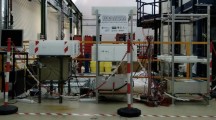Abstract
We report on the study of thermal neutron flux using monitors based on mixture of ZnS(Ag) and LiF enriched with a lithium-6 isotope at the deep underground laboratory DULB-4900 at the Baksan Neutrino Observatory. An annual modulation of thermal neutron flux in DULB-4900 is observed. Experimental evidences were obtained of correlation between the long-term thermal neutron flux variations and the absolute humidity of the air in laboratory. The amplitude of the modulation exceed 5% of total neutron flux.
Similar content being viewed by others
References
Yu. M. Gavrilyuk, A. M. Gangapshev, V. V. Kazalov, et al., “Indications of capture in 78Kr”, Phys. Rev. C 87, 035501 (2013).
Yu. M. Gavrilyuk, A. M.Gangapshev, V. V. Kazalov, et al., “First result of the experimental search for the -capture of 224Xe with the copper proportional counter”, Phys. Part. Nucl. 46 (2), 147 (2015).
V. N. Gavrin, “The Russian-American gallium experiment SAGE”, Phys. Usp. 54, 941 (2011).
V. V. Kuzminov, “The Baksan Neutrino Observatory”, Eur. Phys. J. Plus. 127, 113 (2012).
Ju. M. Gavriljuk, A. M. Gangapshev, A. M. Gezhaev, et al., “Working characteristics of the New Low Background Laboratory (DULB-4900, Baksan Neutrino Observatory)”, Nucl. Instr. Meth. A 729, 576 (2013); arXiv: physics.ins-det/1204.6424. doi 10.1016/j.nima.2013.07.09010.1016/j.nima.2013.07.090
Yu. V. Sten’kin, “Large scintillator detector for thermal neutron recording”, Nuclear Track Detectors: Design, Methods and Applications ISBN: 978-1-60876-826-4, Ed. by M. Sidorov and O. Ivanov, 2010, Ch. 10, pp. 253–256.
V. V.Alekseenko, Yu. M. Gavriluk, V. V. Kuzminov, and Yu. V. Stenkin, “Tidal effect in the radon-due neutron flux from the Earth’s crust”, J. Phys.: Conf. Ser. 203, 012045 (2010).
Author information
Authors and Affiliations
Corresponding author
Additional information
Talk at The International Workshop on Prospects of Particle Physics: “Neutrino Physics and Astrophysics” February 1–8, 2015, Valday, Russia.
The article is published in the original.
Rights and permissions
About this article
Cite this article
Alekseenko, V.V., Gavrilyuk, Y.M., Gangapshev, A.M. et al. The study of the thermal neutron flux in the deep underground laboratory DULB-4900. Phys. Part. Nuclei 48, 34–37 (2017). https://doi.org/10.1134/S1063779616060022
Published:
Issue Date:
DOI: https://doi.org/10.1134/S1063779616060022




